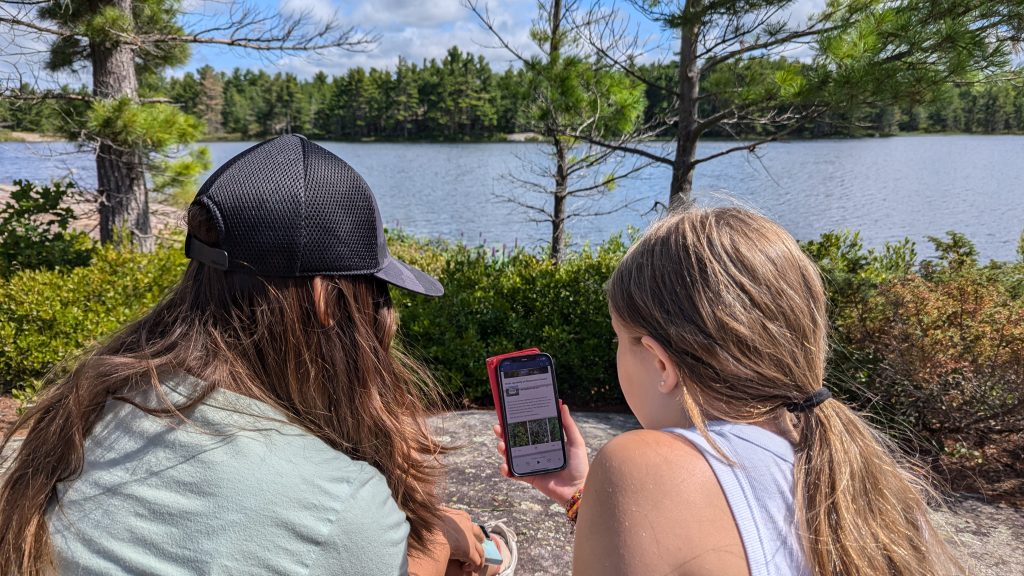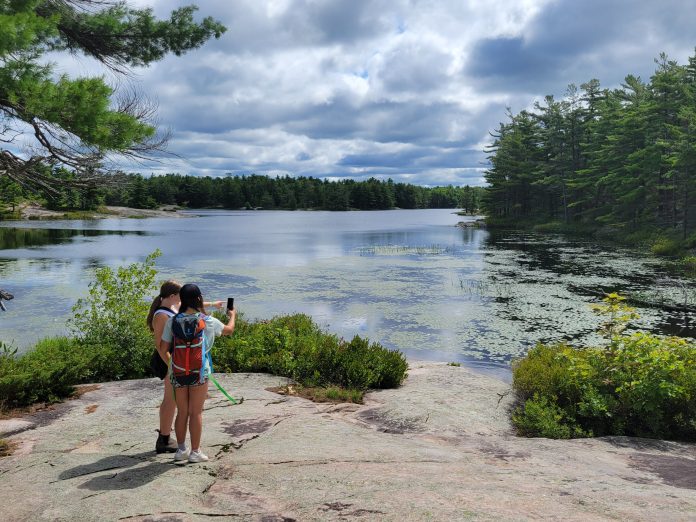A recently launched guided tour on the Parks Canada app offers a new way to explore the cultural and physical landscapes of Georgian Bay Islands National Park.
Parks Canada released the 2.5-kilometre route for Fairy Trail on northern Beausoleil Island in mid-July. The speakers are knowledge-holders from Anishinaabe First Nations, including Trish Monague, a cultural teacher and member of Beausoleil First Nation, and Erika Wabigwan, a member of the Georgian Bay Islands Cultural Advisory Circle and a former Parks Canada employee. The third speaker, Shawn Corbiere, works as an Indigenous liaison and naturalist in the park. Corbiere said many visitors have an interest in history and culture, so the app allows them to experience the park in a deeper, more personal way.
“You’re going to learn a little bit about the Canadian Shield because, here in the park, we straddle two ecozones where the St. Lawrence lowland region meets the Canadian Shield,” Corbiere said. “We also have a little lake up in the Canadian Shield as well on the north end of the park. It’s steeped in legends, so we share that legend on that app as well.”
Along with the legends of Fairy Lake, Corbiere and the other speakers talk about the animals, plants and history on the island. Monague starts the tour by asking participants to walk with reverence as they hike through the park.
One of the creatures visitors may encounter is the Massasauga Rattlesnake. Though it’s the only venomous snake in Ontario, it’s not much cause for concern given its shy demeanor and threatened status. On the tour, Corbiere talks about the rattlesnakes’ history of helping promote balance, rattling their tails to tell gatherers when to move on from a patch of berries.
They also touch on the plants and sacred medicines used on the island, including tobacco or Semaa, as it’s known in the Anishinaabe language. They talk about the role of juniper in creating harmony with other plants and how First Nations mothers used sphagnum moss to create absorbent diapers. Monague also talks about the role of women as waterkeepers.
The tour can be done in the park, where prompts will pop up as participants walk the trail. Visitors can also use the tour while they boat, bike or otherwise enjoy the park, but for people who can’t make it there in person, the tour can be done virtually from anywhere in the world. It doesn’t fully serve it justice, Corbiere said, but it paints a picture of the park and its storied past.
“When I heard it, I wasn’t in the park, but it still brought me there, which is really neat,” he said. “It’s hard to do. But everybody has a cell phone nowadays, and it’s really, really accessible.”

Corbiere said sharing the culture and the landscape is what it’s all about for him. The first tour is just the tip of the iceberg for the stories on the island, so he looks forward to putting together more guided tours in the future, especially after getting good feedback on the first one.
As a traditional flint knapper, he hopes to showcase the sounds and stories behind the creation of stone tools. Flint knapping is the art of shaping rocks into tools by chipping away at the excess material, and it has a history on the island that goes back over 5,000 years.
He also oversees several cultural programs as the park’s Indigenous liaison and naturalist. The park team offers a waterbug adventure for children and families, a natural cultural history hike, and an art of fire program that shows three methods of building a fire. Corbiere also does flint knapping demonstrations and talks on bear safety.
The park often gets visits from organizations like the Ontario Native Women’s Association, and another way their team connects with the community is through archeological digs. It’s essential to get youth and elders alike out to these digs, Corbiere said, because it goes back to the ancestors who lived on the island thousands of years before.
“The archeologists are there to mitigate the cultural resource management,” he said. “We have a trail that’s been heavily used and these artifacts are coming right to the surface, so they come in there and they extract it and then we protect it.”
More than anything, Corbiere wants to urge Canadians to visit their national parks. He said too many people forget that these spaces are there for them, so he hopes people enjoy the parks and help protect biodiversity along the way.
Whether it’s camping, hiking or taking the DayTripper for a ride with park staff, there are dozens of ways to explore Georgian Bay Islands National Park, and now the tour is one of them.
“We’re also the smallest national park in Canada, and we’re the only island park in Canada that has all its amenities in the park,” Corbiere said. “You can glamp, you can bike, you can hike, you can primitive camp. All those beautiful things.”
Download the Parks Canada app to take the tour, and visit the Parks Canada website for more information on Georgian Bay Islands National Park.








